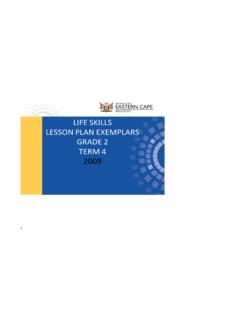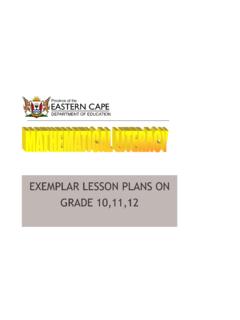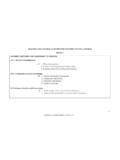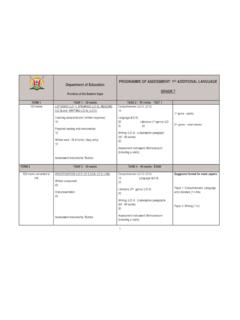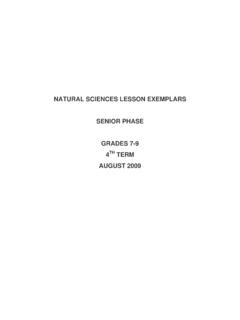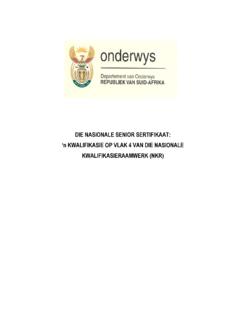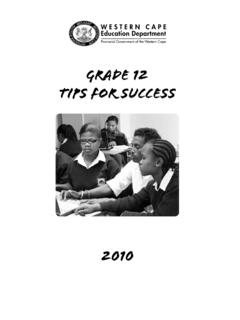Transcription of SENIOR PHASE LESSON PLAN EXEMPLAR GRADE 7-9
1 1 Province of the Eastern Cape DEPARTMENT OF EDUCATION ISEBE LEZEMFUNDO DEPARTMENT VAN ONDERWYS _____ SENIOR PHASE LESSON PLAN EXEMPLAR GRADE 7-9 2 TABLE OF CONTENTS CONTENT PAGE PREFACE 1 TABLE OF CONTENTS 2 INTRODUCTION 3 GRADE 7 LESSON PLAN EXEMPLARS 4-10 GRADE 8 LESSON PLAN EXEMPLARS 11-19 GRADE 9 LESSON PLAN EXEMPLARS 20-27 PHYSICAL DEVELOPMENT& MOVEMENT 28 GRADE 7 LESSON PLAN EXEMPLARS 29-37 GRADE 8 LESSON PLAN EXEMPLARS 38-44 GRADE 9 LESSON PLAN EXEMPLARS 45-50 3 INTRODUCTION The Eastern Cape Department of Education, Curriculum Chief Directorate in collaboration with the District Curriculum Advisors developed this document that seeks to support teachers in planning for teaching, learning and assessment for effective implementation of the National Curriculum Statement in the Intermediate PHASE . This document serves to assist teachers with daily teaching, learning and assessment in life orientation for grades 7-9.
2 These are exemplars of LESSON plans and this means that teachers can use, adapt and refine these. The resources that are indicated are a guide you are at liberty to use other relevant material. The worksheets that are provided are to be utilised as they are part of assessment. life orientation is allocated two hours per week according to policy. One hour is for Learning Outcomes 1, 2, 3 & 5and one hour for Learning Outcome 4 Physical Movement. This time allocation for life orientation must be adhered to. All the LESSON plans have been designed to cover learning outcomes and assessment standards for the second term according to the work schedule. 4 GRADE 7 LESSON PLAN EXEMPLAR Duration 11hrs SELECTED LOs & ASs CONTENT Teaching and Learning Activities Assessment Details LO 5 orientation TO THE WORLD OF WORK AS1: Discusses interests and abilities related to career and study opportunities.
3 AS 3: Identifies services and sources for career and study information. AS 4: Reports on an initiated or simulated career related activity Careers Individual interests and abilities. Interests are things that you find fascinating and abilities are things that you are good at in accordance with each career Study opportunities , HEIs HEIs PACE Careers A-Z Career related activities interviews, job shadowing ( take a girl child to work) Activity 1 Learners brainstorm careers they know and after that in groups of five they choose a career and discuss what the career entails .Learners in their groups differentiate between interests and abilities. They make use of the career they have chosen and relate interests and abilities to the career. They write this information in their books. Each group makes a presentation on this information to the class and the rest of the class discusses the presentation to get a better understanding.
4 Activity 2 Learners list HEIs they know and courses each institution offers. Learners investigate institutions that offer funding and the requirements to qualify for funding. They are encouraged to look for more information on this in newspapers and other publications to develop their own resources on HEIs. Teacher consolidates these activities by supplying learners with information on HEIs, courses offered and availability of funding. Activity 3 Each group using the chosen career simulates or do a role play of the chosen career demonstrating what the career is all about. Other groups may do an interview highlighting the interests and abilities related to the career. The group has to prepare the questions before hand in preparation Teacher observation Written work Observation Role play / simulation Observation Sheet 5 LO3 PERSONAL DEVELOPMENT AS2: Evaluates media and other influences on personal lifestyle choices and proposes appropriate AS5 Demonstrates and reflects on decision -making skills Different types of media Media influence fashion, relationships, sexual activities, violence , substance abuse, pornography and stereotyping of the interview.
5 Learners can also go to the real world of work and be part of a day s work ( job shadowing) going to the surgery of a dentist to experience what a day of a dentist looks like. They write a paragraph on their experience. Activity 4 Learners to bring to class newspapers with job information. They cut out jobs they cut out jobs of their interest and paste to table that will be filled. See annexure Activity 5 Learners report on what they have observed. Activity 1. Each learner is asked to take a minute and think about herself/himself. She/ he writes down what influences her lifestyle the way she talks, behaves, dresses, making friends, what she eats and drink, etc. Learners talk about what influences their lifestyles parents, siblings, friends, magazines and TV. The teacher asks the learners to mention different types of media and the influence they have on their lifestyle. Activity 2. Learners cut pictures of adverts showing positive and negative influences.
6 They paste these in their books and evaluate how these adverts influence their lifestyle. Activity 3 Each learner thinks of a situation in which he had to take a decision. Learners write this in their books making use of the following statements: Written task Oral presentation Observation Written task Rubric 6 LO 2 SOCIAL DEVELOPMENT AS 4: Explains how recognition of diverse culture can enrich South African society. AS 5:Explains the role of oral tradition and scriptures in a range of world s religion Diversity in terms of religion, language, food and culture Oral tradition and scriptures Describe the problem fully. List all the choices you had .Match each choice with a consequence. Make your choice Activity 1 Learners brainstorm different cultures they know. They talk about their own cultures, the uniqueness of their culture in relation to other cultures. Activity 2 Teacher gives a scenario that depicts a conflict because of cultural differences.
7 Activity 3 Learners to identify the causes of conflict in the scenario and these should be cultural related. Learners give recommendations on how this conflict could have been avoided. They must think of how tourism, sport, music and even food from different cultures can enrich the South African society. Learners write this in their work book. This scenario can also be role played and in the play learners show how they would play a reconciliatory role. Learners can also design and make a collage of different cultures using food, dress, religion ,etc. Activity 1 Learners using dictionaries look up the meaning of oral tradition and scriptures. They write this in their books. Learners list religions that they know especially those in their communities. The teacher consolidates this session by explaining the role of oral tradition in Written task Rubric Role play Observation Sheet Design and make Rubric 7 LO 1 HEALTH PROMOTION AS1:Proposes ways to improve the nutritional value of own personal diet Healthy eating means eating a balanced diet that provides all nutrients that the body needs.
8 Improving personal diet. Benefits of healthy eating relation to religions using the table. See annexure Oral tradition and scriptures is used to communicate a code of conduct that shows people how to behave. Oral tradition is carried from culture to culture, generation to generation through telling stories. Activity 2 Learners are given homework to go and talk to their parents or even church elders about oral traditions and scriptures of their religion. They can also interview other religions on this. The teacher to assist learners in drawing up questions to use for the interview. Learner write their findings. Activity 3 Learners learn the information on the annexure and compare with their findings. See annexure Activity 1 In pairs learners talk about what they usually eat for breakfast, lunch and supper. The learners write this in their workbook. The teacher consolidates by emphasizing the importance of eating all three meals per day.
9 Activity 2 Learners look into what they have written and talk about the nutritional value of what they eat daily. They draw a table indicating the food they eat. The next column indicate nutrients found in their food. Activity 3 Teacher reminds the learners about the food pyramid. Using the food pyramid the learners look into the Informal assessment Written task Check list 8 AS2:Evaluates actions to address an environmental health problem Identifying an environmental health problem nutritional value of what they eat and proposes ways to improve it. Activity 4 Learners fill in the table on good eating habits. See annexure. Activity 1 Learners in pairs talk about environmental health problems they identified in grades 4,5 & 6. Some examples are littering, air and water pollution, sanitation, etc. They also tried to address these problems by engaging in a project on stopping littering for an example.
10 Activity 2 Learners in groups list actions they took to address these problems. Each group can take a different issue and address it. Activity 3 Learners in groups evaluate these actions using the following guidelines: Was the action realistic? Was everybody involved? Was it effective? Was it sustainable? Learners write this evaluation in their books and hand it in for assessment Written work Memo Resources: Careers A-Z, magazines, newspapers, policy on religions, posters and DWAF material Teacher Reflection: 9 ANNEXURE 1 JOB INTERESTS ABILITIES OPPORTUNITIES Pilot Dentist Fashion designer RUBRIC ON CULTURES CRITERIA LEVEL 1 LEVEL 2 LEVEL 3 LEVEL 4 Identified cause of conflict Learner has not identified the cause of conflict Learner has not identified an incorrect cause of conflict Learner has identified the cause of conflict Learner has identified and explained the cause of conflict Related conflict to cultural differences Learner has not related the conflict to cultural differences Learner has related the conflict to cultural differences not in the scenario Learner has related the conflict to cultural differences Learner has related the conflict to cultural differences and shows in depth knowledge of the different cultures.
